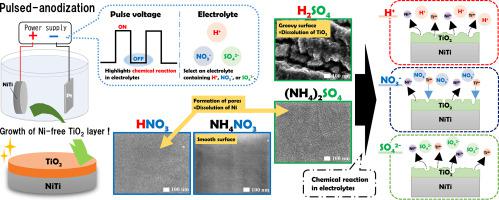Surface & Coatings Technology ( IF 5.3 ) Pub Date : 2021-04-22 , DOI: 10.1016/j.surfcoat.2021.127221 Kako Yamasaki , Hiroki Taniho , Kasumi Tate , Naofumi Ohtsu

|
Growing an oxide layer on an almost equiatomic NiTi alloy using anodization is challenging owing to the presence of Ni in the alloy. Pulsed voltage can highlight the chemical reactions occurring with the electrolyte to obtain a Ni-free TiO2 layer. For a better understanding of this technique, we investigated the effect of electrolyte ionic species on the growth of a Ni-free TiO2 layer. The H+ and SO42− ions in the electrolyte withdraw Ni from the growing layer, whereas the coexistence promotes layer dissolution. Therefore, H2SO4 facilitated the formation of a Ni-free TiO2 layer with a groove-like surface, while (NH4)2SO4 led to a smoother surface than that in the presence of H2SO4. When NO3− is present in the electrolyte, it behaved as an oxidizing agent and promoted layer growth. Thus, anodizing in HNO3 resulted in the thickest layer with nanometer-sized pores as the vestiges of Ni removal owing to supplementary action by the H+ ions. However, NH4NO3 did not form such an oxide layer. The corrosion-protective function was dominated by the surface characteristics, and the HNO3-anodized surface exhibited inferior properties owing to pore corrosion.
中文翻译:

NiTi合金脉冲阳极氧化过程中的电解质效应,形成无镍氧化物层
由于阳极中存在镍,使用阳极氧化在几乎等原子的NiTi合金上生长氧化物层具有挑战性。脉冲电压可以突出显示与电解质发生的化学反应,以获得不含Ni的TiO 2层。为了更好地理解该技术,我们研究了电解质离子种类对无Ni TiO 2层生长的影响。电解质中的H +和SO 4 2-离子从生长层中抽出Ni,而共存则促进了层的溶解。因此,H 2 SO 4有助于形成具有槽状表面的无Ni的TiO 2层,而(NH 4)2 SO 4导致的表面比H 2 SO 4存在的表面更光滑。当NO 3 -存在于电解液中,它的表现作为氧化剂和促进层的生长。因此,由于H +离子的补充作用,HNO 3中的阳极氧化导致最厚的层具有纳米尺寸的孔作为Ni去除的残留物。但是,NH 4 NO 3没有形成这样的氧化物层。腐蚀防护功能受表面特性支配,由于孔腐蚀,HNO 3阳极氧化的表面表现出较差的性能。











































 京公网安备 11010802027423号
京公网安备 11010802027423号